 |
PO Box 9021,
Wilmington, DE 19809, USA
E-mail: font@focusonnature.com
Phone: Toll-free in USA 1-888-721-3555
or 302/529-1876 |
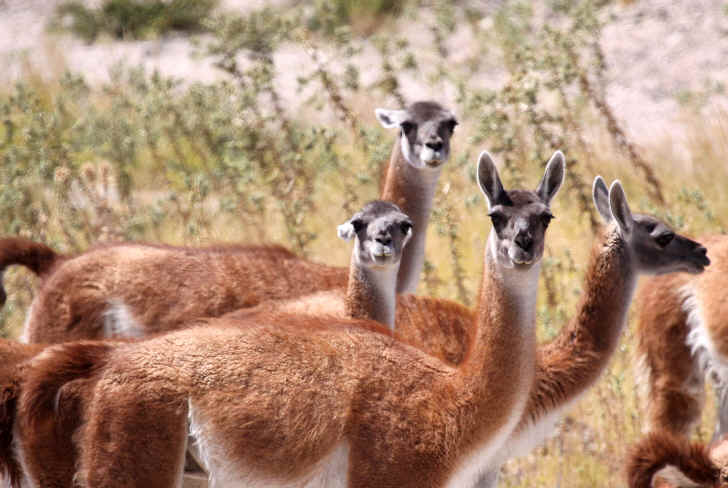 MAMMALS
MAMMALS
in Argentina
Noting those during
Focus On Nature Tours
1991 thru 2014
During the months of
October, November, December
A List of Argentina Mammals compiled by Armas
Hill,
the leader of FONT tours
in that country
PHOTO AT UPPER RIGHT: GUANACOS,
photographed during a FONT Southern Argentina Tour in December 2013
(photo by Marie Gardner)
There have been 14 FONT tours in Argentina.
Mammals seen during FONT tours noted with an (*).
Codes:
(t): a globally threatened
species,
designated by the IUCN
(the
International Union for Conservation of Nature)
(t1): critically
endangered (t2): endangered (t3):
vulnerable
(nt): a globally near-threatened species, designated by the IUCN
(ARi): introduced species in Argentina
IN VARIOUS REGIONS OF ARGENTINA
ba:
in and near Buenos Aires
fs:
far-southern Argentina, including Patagonia and Tierra del Fuego (tf)
nc:
in north-central Argentina, including areas south from Jujuy (Calilegua Nat
Park), and Salta, to Tucuman and Cordoba
ne:
in northeast Argentina, including the areas of Iguazu (in Missiones) and the
Ibera Marshes (in Corrientes), and in between
nw:
in northwest Argentina (north of Jujuy), including the Altiplano
so:
in southern Argentina, including the Valdez Peninsula, and nearby areas to the
north & south, including Chubut
(ph): species with a photo in the FONT website
Links to Mammal Groupings in this list:
Opossums
Armadillos Anteaters
New World
Monkeys Dogs & Foxes
Cats Bear
Raccoon & Coati Skunks, Otters, allies
Tapir Peccaries
Camels
Deer Coypu
Capybara Porcupines
Squirrels Agoutis & Paca
Cavies
Tuco-tucos Chinchillas, Viscachas
Rabbits Bats Whales, Dolphins,
Porpoises Seals
Other Links:
Upcoming
FONT Birding & Nature Tours in Argentina
A Complete List (with some photos) of Argentina Birds, in 2
parts:
List 1: Tinamous to Flycatchers List
2: Antshrikes to Grosbeaks
A
South
American Mammal List
(with
some photos)

Land Mammals:
MONITO DEL MONTE - Family
Microbiotheriidae
- Monito del Monte ______
Dromiciops gliroides
AR name: Monito del Monte
AMERICAN OPOSSUMS - Family Didelphidae
- White-eared Opossum (ph) (*) ______ ne
Didelphis albiventris
AR name: Comadreja Picaza
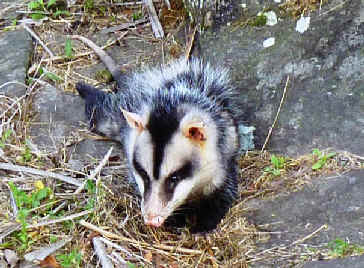
A White-eared Opossum photographed during a FONT
tour
(photo by Bob Enever)
- Big-eared Opossum (*) ______ ne
(was part of the Southern, or Black-eared
Opossum, Didelphis marsupialis)
Didelphis aurita
AR name: Comadreja de Orejas Negras
- Agile Gracile Opossum ______
Gracilinanus agilis
AR name: Comadrejita agil
- Brazilian Gracile Opossum ______
Gracilinanus
microtarsus
- Lutrine Opossum ______
Lutreolina crassicaudata
AR name: Comadrejita colorada
- Tate's Woolly Mouse Opossum
______ ne
Marmosa paraguayanus
AR name: Marmosa
cenicienta
Marmosa paraguayanus was part of what
is now the more-northerly White-bellied Woolly Opossum, Marmosa
demerarae, which was
Micoureus demerarae.
In 2009, Micoureus became a
subgenus, with Marmosa being the
genus in the scientific name of this species and the one that follows.
- White-bellied Woolly Mouse Opossum
______ nw
Marmosa constantiae
- Gray Short-tailed Opossum ______
Monodelphis domestica
AR name: Colicorto chaueno
- Elegant Fat-tailed Mouse Opossum
______ (or, in Argentina the Common Mouse Opossum)
Thylamys elegans
AR name: Comadrejita comun
- Common Fat-tailed Mouse Opossum
______ (or the Austral Mouse Opossum)
Thylamys pusillus
AR name: Comadrejita enana
ARMADILLOS - Family Dasypodiidae

- Southern Long-nosed Armadillo (nt)
(*) ______ ne
Dasyous hybridus
AR names: Mulita Pampeana, Tatu Mulita
- Seven-banded
Armadillo ______
Dasyous septemcinctus
- Nine-banded Armadillo (ph)
______
Dasypus novemcinctus
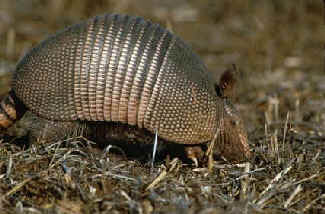
Nine-banded Armadillo
- Yunga's Lesser Long-nosed
Armadillo ______ (another name is Yepes' Mulita)
Dasypus yepsei
Dasypus yepsei
was described in 1995.
- Chacoan Naked-tailed
Armadillo (nt) ______
Cabassous shacoensis
AR name: Tatu-piche
- Greater Naked-tailed Armadillo
(*) ______ ne
Cabassous tatouay
- Screaming Hairy Armadillo ______
Chaetophractus vellerosus
AR name: Piche Lloron
- Big Hairy Armadillo (ph) (*)
______ so
Chaetophractus villosus
AR name: Peludo
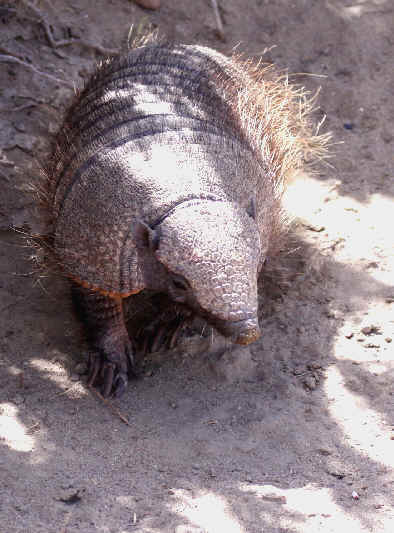
Above & below: the
Big Hairy Armadillo, photographed during
the FONT tour in southern Argentina in December 2013
(photo by
Marie Gardner)
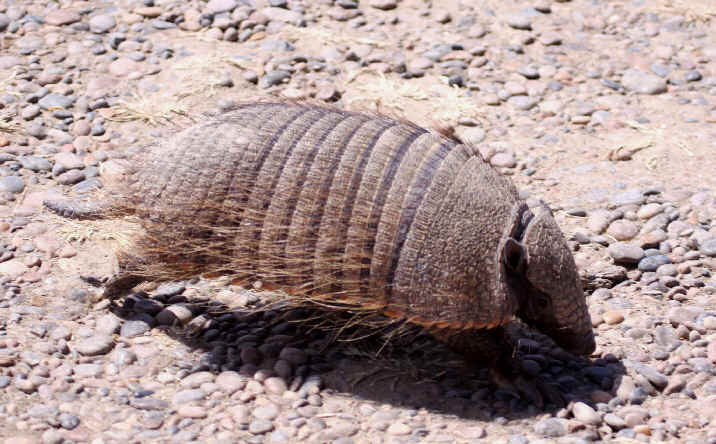
- Andean Hairy
Armadillo (t3) ______
Chaetophractus nationi
- Greater Fairy
Armadillo ______
Calyptophractus retusus
- Pink Fairy
Armadillo ______
Chlamyphorus truncatus
- Giant Armadillo
(t3) (ph) ______
Priodontes maximus
AR name: Tatu carreta
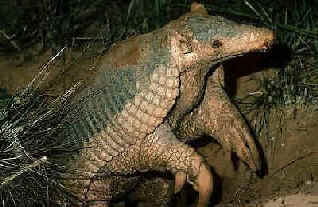
Giant Armadillo
- Southern Three-banded
Armadillo (nt) ______
Tolypeutes matacus
AR name: Mataco
- Six-banded
Armadillo (ph) ______ (another name is
Yellow Armadillo)
Euphractus sexcinctus
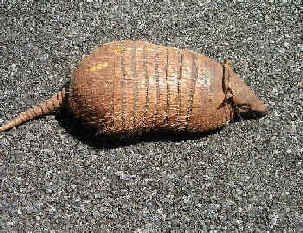
Six-banded Armadillo
- Pichi Armadillo (nt) (*) ______ fs
Zaedyus pichiy
(the single member of its genus)
AR name: Pichi Patagonico
ANTEATERS - Family Myrmecophagidae
- Giant Anteater (t3)
(ph) ______
Myrmecophaga tridactyla
AR name: Oso hormiguero
- Southern Tamandua
______ (also called Collared Tamandua)
Tamandua tetradactyla
AR name: Oso melero
NEW WORLD MONKEYS - Family Atelidae
- Black Howler Monkey (ph) (*) ______
ne
Alouatta caraya
AR names: Mono Aullador Negro, Caraya
The male Black Howler Monkey is black; the female is
brown.

Above: male Black Howler Monkey
Below: female Black Howler Monkey
Both were photographed during a FONT tour.
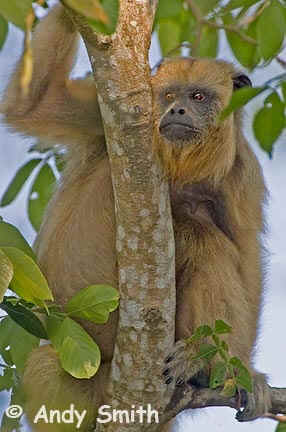
- Brown Howler Monkey (ph)
______ ne
Alouatta guariba
AR name: Caraya Rojo
The subspecies of the Brown Howler Monkey in Argentina is
the Southern Brown Howler, one of two subspecies of the species: Alouatta
guariba clamitans.
The other subspecies, the nominate, is the Northern Brown Howler in Brazil
in eastern Minas Gerais and Bahia. It is critically endangered.
Overall, the species. Alouatta guaiba, was classified as endangered,
but now is said to be "of least concern".
- Black Capuchin (nt)
______ nc
Sapajus
(formerly Cebus) nigritus (the genus was
changed to Sapajus
in 2011)
AR name: Mono Cai
This mammal in northern Argentina was part of the now more-northerly
Tufted Capuchin, formerly the Brown Tufted Capuchin, Cebus
apella.
Sapajus nigritus occurs in Argentina, among other places, in the
Calilegua and El Rey national parks.
- Black-striped Capuchin (*) ______ ne
Sapajus (formerly Cebus) libidinosus
(the genus was changed to Sapajus
in 2011)
AR name: Mono Cai
This mammal in northeastern Argentina has formerly been known as the Black-striped
Tufted Capuchin and the Black-capped Capuchin, and has been part
of Cebus apella.
- Azara's Night
Monkey ______
Aotus azarai
AR name: Mirikina
DOGS & FOXES - Family Canidae
- Maned Wolf (nt) (ph) (*) ______
ne
Chrysocyon brachyurus (the single member of its genus)
AR names: Aguara Guazu, Lobo de Crin
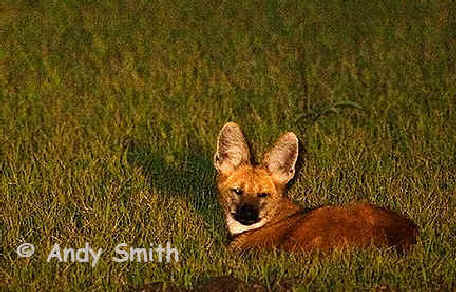
A Maned Wolf photographed during a FONT tour
- Colpeo Fox (*) ______ fs
(tf)
Lycalopex culpaeus
(the genus has previously been Pseudalopex, and Dusicyon)
AR name: Zorro Colorado
On Tierra del Fuego, this mammal was called the "Fuegian Fox", Pseudalopex
c.
magellanicus.
- South American Gray Fox (ph) (*) ______
fs (tf) nc so
Lycalopex griseus (the
genus has previously been Pseudalopex, and Dusicyon)
griseus
AR names: Zorro Gris, Zorro Patagonico, Chilla
Lycalopex griseus
is said to include the "Pampas Fox".
The "Pampas Fox", of central & eastern Argentina has been said
to
be Lycalopex gymnocercus,
with the AR
name: Zorro
Pampas
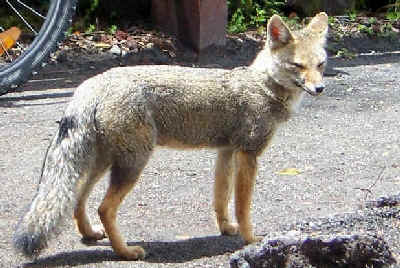
Above & below: a Pampas, or South
American Gray Fox
photographed during FONT tours
The one in the lower photograph was on the Valdes Peninsula
during the FONT Southern Argentina Tour in December 2013.
(upper photo by Robert Hinz; lower photo by Marie Gardner)
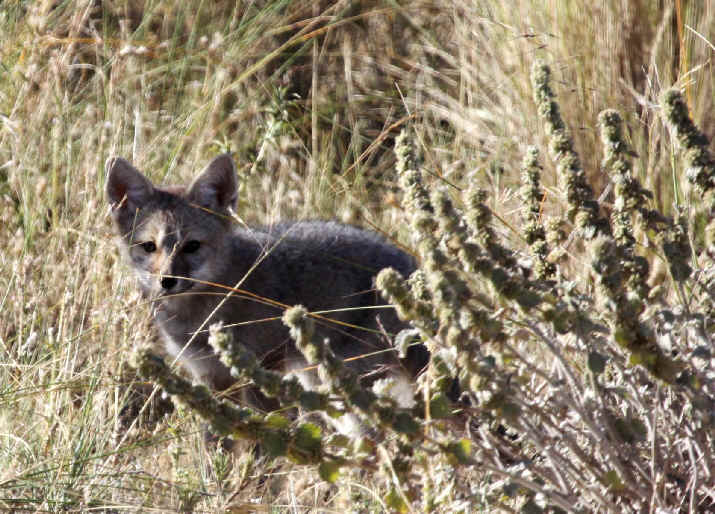
- Crab-eating Fox (ph) (*) ______
ne
Cerdocyon thous (was Dusicyon thous)
(the single member of its
genus)
AR name: Zorro de Monte
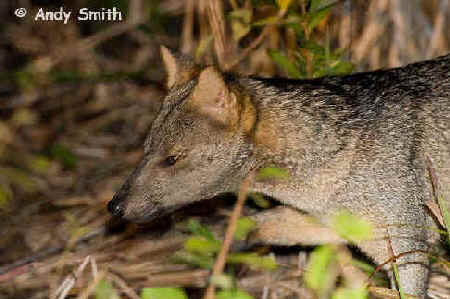
A Crab-eating Fox photographed during a FONT tour.
- Bush Dog (nt) ______
Speothos
venaticus
CATS - Family Felidae
- Jaguarundi ______
Puma
(formerly Herpailurus) yaguarondi
AR name: Yaguarundi
- Ocelot (ph)
______
Leopardus pardalis
AR name: Ocelote
- Oncilla (t3) ______ (other names are the Little Spotted
Cat, or Little Tiger Cat)
Leopardus tigrinus
AR name: Tirica
- Margay (nt) ______
Leopardus wiedii
AR name: Margay
- Pampas Cat (*) ______
so
Leopardus
(formerly
Lynchailurus) pajeros
AR name: Gato de Pajonal
- Geoffroy's Cat (nt) (*)
______ fs
Leopardus (formerly
Oncifelis)
geoffroyi
AR name: Gato Montes
- Austral Spotted Cat (t3)
______ (another name is Kodkod)
Leopardus
(formerly Oncifelis) guigna
AR name: Gato Huina
- Puma (ph)
______ (another name is Cougar)
Puma concolor
AR name: Puma
- Jaguar (nt) (ph)
______
Panthera (formerly Jaguarius) onca
AR name: Yaguarete
BEAR - Family Ursidae
-
Spectacled Bear (t3) ______
Tremarctos ornatus
RACCOONS - Family Procyonidae
- Crab-eating Raccoon
(ph) ______
Procyon cancrivorus
AR name: Aguara Pope
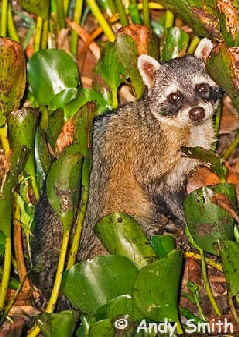
A Crab-eating Raccoon
photographed during a FONT tour
- South American Coati (ph) (*) ______
ne
Nasua nasua
AR names: Coati, Pisote
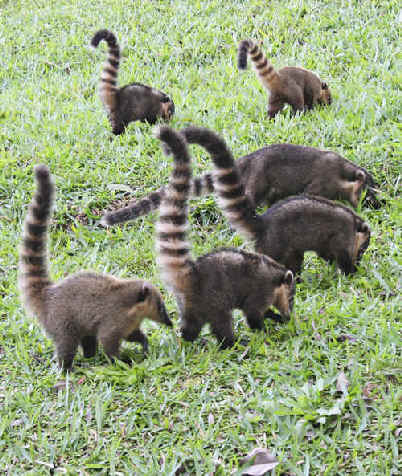
South American Coatis photographed during a FONT
tour
in the area of Iguazu Falls
SKUNKS & ALLIES - Family Mustelidae
- Molina's Hog-nosed Skunk
______
Conepatus chinga
AR name: Zorrino Comun
- Humboldt's Hog-nosed Skunk (ph) (*) ______
fs
Conepatus humboldti
AR name: Zorrino Patagonico, Zorrino Austral
Conepatus humboldti has also
been called the Patagonian Hog-nosed Skunk.
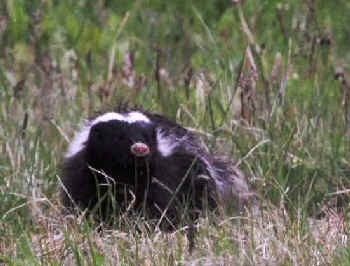
A Humboldt's, or Patagonian Hog-nosed Skunk
photographed
during the FONT tour in southern Argentina in December 2013
(photo by Marie Gardner)
- Neotropical River Otter
______
Lontra longicauda
AR name: Lobito de Rio
- Southern River Otter (t2)
______
Lontra provocax
- Marine Otter (t2) (ph) ______
Lontra felina
- Giant Otter (t2) (ph) ______
Pteronura brasilensis
AR name: Lobo gargantilla
- Tayra ______
Eira barbara
AR name: Huron Mayor
- Lesser
(or Southern) Grison
(ph) (*) ______ so
Galictis cuja
AR name: Huron menor
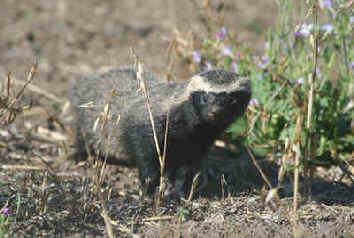
Lesser Grison
- Patagonian Weasel ______
Lyncodon
patagonicus
TAPIR - Family Tapiridae
- Lowland Tapir (t3) (ph) ______
(has been called Brazilian Tapir)
Tapirus terrestris
AR name: Tapir
PECCARIES - Family Tayassuidae
- Collared Peccary (ph) ______
Pecari tajacu
AR name: Pecari de collar
- White-lipped Peccary (ph)
______
Tayassu pecari
AR name: Pecari Labiado
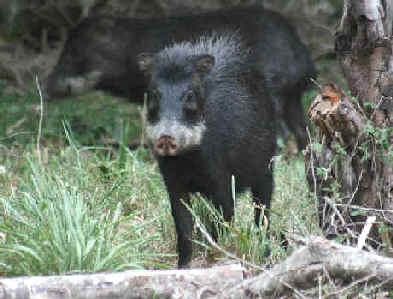
White-lipped Peccary
- Chacoan Peccary (t2) ______
Catagonus wagneri
CAMELS - Family Camelidae
- Guanaco (ph) (*) ______ fs
Lama guanicoe
AR name: Guanaco
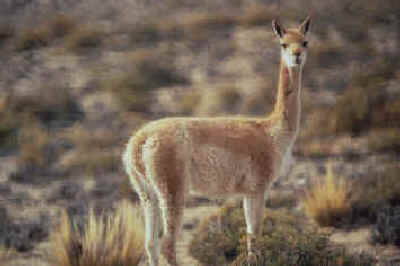
A Guanaco photographed during a FONT tour. This
animal has been
seen during our tours in both Argentina & Chile.
The photo below was taken during the FONT tour in Southern Argentina in
December 2013.
It shows how the Guanaco jumps the fence. It stops, and then springs up into
the air.
(photo by Marie Gardner)
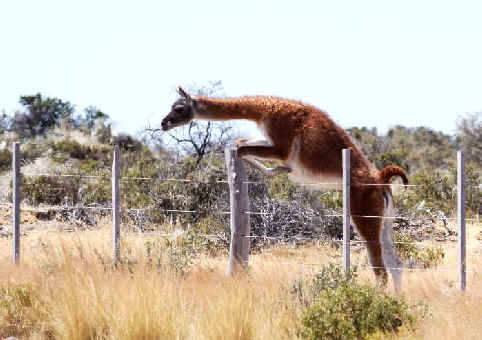
- Vicuna (v) (*) ______ nw
Vicugna vicugna
AR name: Vicuna
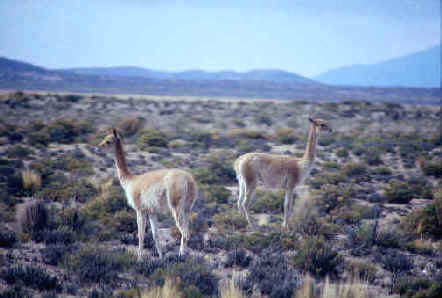
Vicunas photographed during a FONT tour. This
animal has been seen
during our tours in northwest Argentina & in northern Chile.
- Llama (*) ______ (a domesticated animal)
Lama glama
AR name: Llama
There are 4 species of South American Lamoids.
Two are wild (the Vicuna
and
the Guanaco).
Two are domesticated (the Llama
and the Alpaca).
In Argentina: there are 8% of the South American Lamoids, including 96% of the
Guanacos.
DEER - Family Cervidae
- Marsh Deer (t3) (*) ______
ne
Blastocerus dichotomus (the single member of its genus)
AR name: Ciervo de los Pantanos
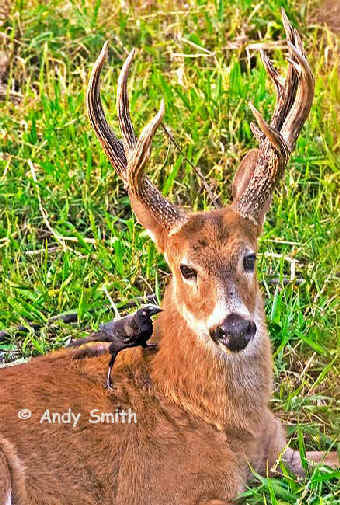
A Marsh Deer (& a Giant Cowbird) photographed during a
FONT tour.
- Gray Brocket Deer (ph) (*) ______
nc ne (also called Brown Brocket
Deer)
Mazama gouazoubira
AR name: Corzuela Parda
- Red Brocket Deer ______
Mazama americana
- Pygmy Brocket Deer
______ ne
Mazama nana
AR name: Corzuela Enana
- Pampas Deer (nt)
(ph) ______
Ozotoceros bezoarticus
AR name: Venado de las Pampas
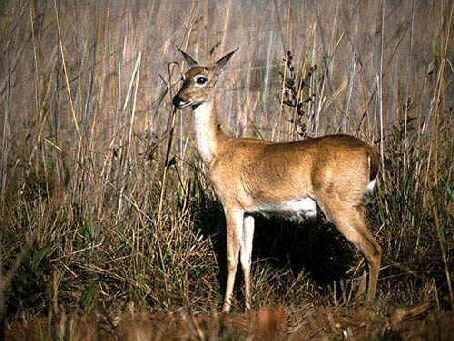
Pampas Deer
- Northern Andean Deer
(t3) (ph) ______ (also called Peruvian, or Northern
Guemal)
Hippocamelus antisensis
- Southern Andean Deer
(t2) ______ (also called Chilean Guemal)
Hippocamelus bisulcus
AR name: Huemal
- Southern Pudu (t3)
(ph) ______
Pudu pudu
AR name: Pudu
SPINY RATS - Family Echimyidae
- Coypu (ph) (*) ______ ba
Myocastor coypus (the single member of its genus)
AR name: Coipo
Myocastor coypus is also known as
the Nutria.
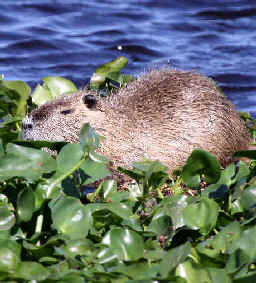
A Coypu, or Nutria photographed during a FONT tour
(photo by Marie Gardner)
CAPYBARA - Family Hydrochoeridae
- Capybara (ph) (*) ______ ne
Hydrochaeris hydrochaeris (the single member of its genus &
family)
AR name: Carpincho, or Puerco de Agua
The Capybara is the world's largest rodent. It is mostly aquatic.

Capybaras photographed during a FONT tour.
BEAVERS - Family Castoridae
- North American Beaver (i) (ph) (*) ______ fs
Castor canadensis
The North American Beaver was introduced into Tierra del
Fuego for their pelts. It is now quite common there.
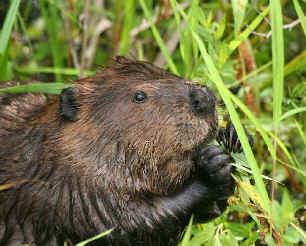
North American Beaver
(photo by Doris Potter)
NEW WORLD PORCUPINES - Family Erethizontidae
- Brazilian Porcupine
______
Coendou prehensilis
- Paraguayan Hairy Dwarf Porcupine ______
(other names are Paraguayan Tree Porcupine,
Lesser Tree
Porcupine)
Sphiggurus spinosus
AR name: Coendu Misionero
SQUIRRELS - Family Sciuridae
- Guianan Squirrel (*) ______ ne
(also called Brazilian Squirrel, or "Olive-colored Squirrel")
Sciurus aestuans
AR name: Ardilla Gris
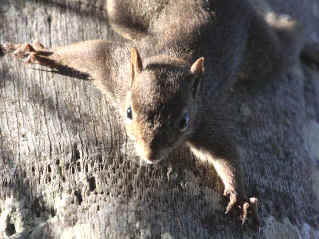
Guianan Squirrel
(photo by Marie Gardner)
- Yungas Squirrel
______ nc
Sciurus ignitus
AR name: Ardilla Roja
AGOUTIS - Family Agoutidae
- Azara's Agouti (*) ______ ne
Dasyprocta azarai
AR name: Acuti Rojizo
- Brown Agouti ______
Dasyprocta variegata
AR name: Acuti Rojizo
The range of the mammal said here to
be Dasyprocta variegata includes southeastern Peru,
far-southwestern Brazil, Bolivia, western Paraguay, and far-northwestern
Argentina.
But this animal is also said by some to a highly disjunct population of the
Central American Agouti, Dasyprocta punctata.
- Lowland Paca ______
(also called Spotted Paca)
Cuniculus (formerly
Agouti) paca
AR name: Paca
Cuniculus paca was
described by Linnaeus in 1766.
NEOTROPICAL RATS & MICE - Family Muridae, Subfamily Sigmodontinae
- Web-footed Marsh Rat (*) ______ ne
(also
called Red Marsh Rat)
Holochilus brasiliensis
AR name: Rata Nutria Comun
- Swamp Rat ______
Scapteromys tumidus
AR name: Rata de Pajonal
- Cursorial Grass Mouse (*) ______ ne
Akodon cursor
AR name: Raton de Monte
- Yellow-nosed Mouse
______
Abrothrix xanthorhinus
AR name: Raton Hocico Bayo
GUINEA-PIGS & CAVIES - Family Caviidae
- Brazilian Guinea-Pig (*) ______ ne
Cavia aperea
AR name: Cuis (Grande), or Cuis Pampeano
Cavia aperea
is also called the Pampas Cavy.
- Montane Guinea-Pig ______
Cavia tschudii
- Common Yellow-toothed Cavy ______
Gale musteloides
- Southern Mountain Cavy (ph) (*) ______ nw
so
Microcavia australis
AR: Cuis Chico, or Cuis de los Salitres
Microcavia australis
is also called the Small Patagonian Cavy, the Southern Dwarf Cavy, or the Least Cavy.
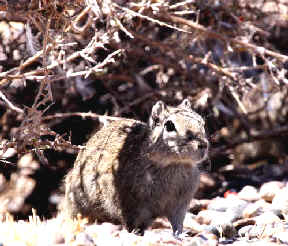
A Small Patagonian Cavy photographed
during
the FONT tour in southern Argentina in December 2013.
This mammal was at the Magellanic Penguin colony
in Punta Tomba. Like the penguins, using burrows.
(photo by Marie Gardner)
- Shipton's Mountain Cavy (nt)
______
Microcavia shiptoni
- Patagonian Mara (nt) (ph) (*) ______
so
Dolichotis patagonum
AR name: Mara (Patagonica) or Liebre Patagonica
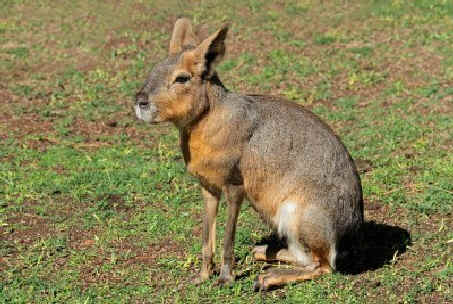
Above & below: the odd mammal known
as the Patagonian Mara, or Mara Patagonica.
It has been seen during FONT tours
on and near the Valdes Peninsula in southern Argentina.

The photo below of a Mara was taken during
the FONT tour
in southern Argentina in December 2013.
(photo by Marie Gardner)
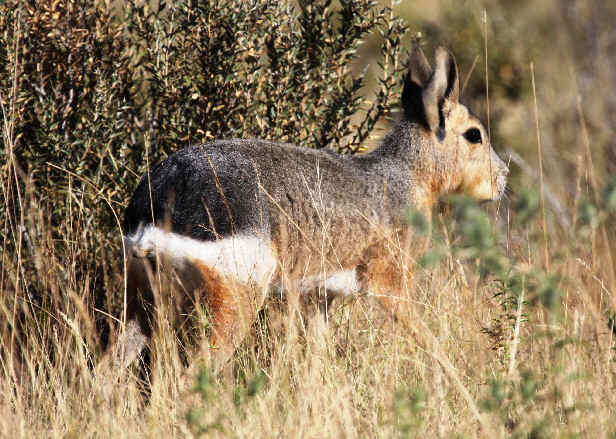
- Chacoan Mara (or Cavy) ______
Pediolagus salinicola
AR name: Conejo de los Palos
TUCO-TUCOS - Family Octodontidae
- Tawny Tuco-tuco (*) ______ nw
Ctenomys fulvus
AR name: Tuco-tuco del Tamarugal
- Ctenomys opimus
AR name: Tuco-tuco Puneno
- Ctenomys australis
AR name: Tuco-tuco Costero
- Magellanic Tuco-tuco (t3) (*)
______ so
Ctenomys magellanicus
AR name: Tuco-tuco Austral
CHINCHILLA-RATS - Family Abrocomidae
- Ashy Chinchilla-Rat (*) ______ nw
Abrocoma cinerea
CHINCHILLAS & VISCACHAS - Family Chinchillidae
- Short-tailed Chinchilla (t1) (ph) (*) ______ nw
Chincilla brevicaudata
AR names: Chincilla Grande, or Chinchilla del Altiplano
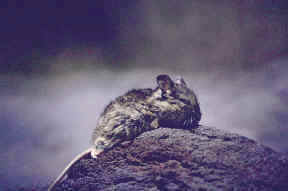
A Short-tailed Chinchilla photographed during a FONT
tour.
- Plains Viscacha ______
Lagostomus maximus
AR name: Vizcacha
- Southern Viscacha (ph) (*) ______ nw
Lagidium viscacia
AR names: Chinchilllon Comun, or Vizcachon, or Vizcacha de la Sierra
What was called the Mountain Viscacha was split into the Southern
Viscacha and the Northern Viscacha (which occurs north of
Argentina).
Until recently, there have been 3 species in the Lagidium
genus. A 4th species, in Ecuador, was recently discovered and
described in 2009.
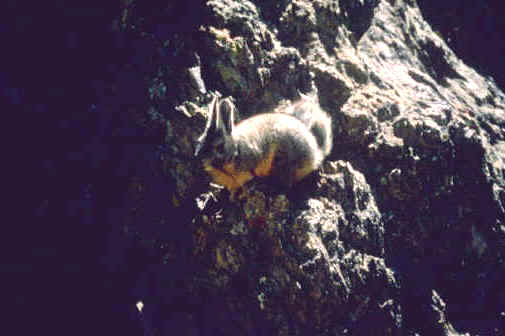
A Southern Viscacha photographed during a FONT tour. This animal has been
seen
during our tours in both Argentina & Chile.
- Wolffsohn's Viscacha ______
Lagidium wolffsohni
AR name: Chinchillon Anaranjado
RABBITS & HARE - Family Leporidae
- Tapeti ______ (also
called Brazilian Rabbit)
Sylvilagus brasiliensis
- European Rabbit (ARi) (*)
______ fs so
Oryctolagus cunicu
- European Hare (ARi) (ph) (*) ______
fs so
Lepus europa
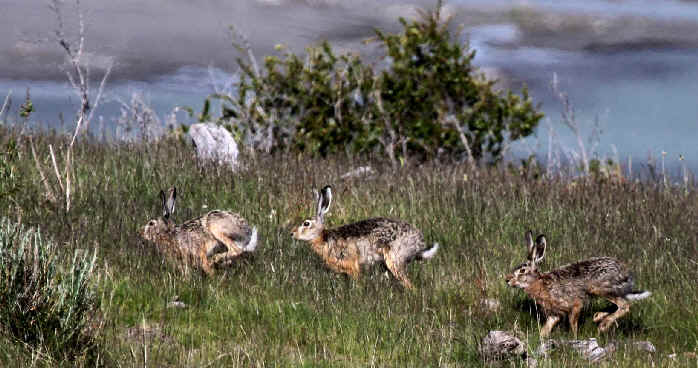
Three European Hares, pursuing and pursued. One both.
During the FONT tour in southern Argentina in December 2013.
(photo by Marie Gardner)
BATS - Order Chiroptera
- Greater Bulldog
(or Fishing) Bat (ph) ______
Noctilio leporinus
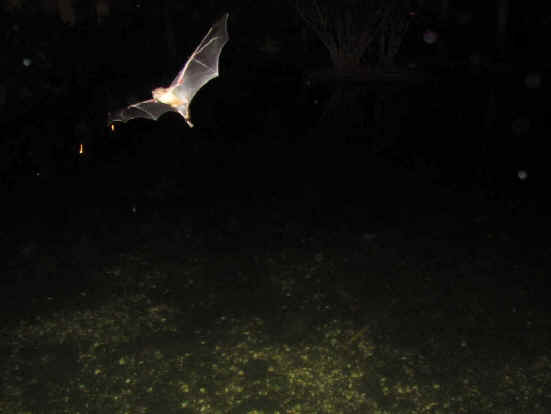
Greater Bulldog Bat
- Lesser Bulldog
(or Fishing)
Bat ______
Noctilio albiventris
AR name: Murcielago Pescador Chico
- Big-eared Woolly Bat ______ (another
name is Wooly False Vampire Bat)
Chrotopterus auritus
AR name: Murcielago Gigante
- Long-legged Bat ______
Macrophyllum
macrophyllum
- Pale Spear-nosed Bat ______
Phyllostomus discolor
- Greater Round-eared Bat ______
Tonatia bidens
- Tailed Tailless Bat ______
(yes, it is the name)
Anoura caudifer
- Pallas' Long-tongued Bat
______
Glossophaga soricina
AR name: Murcielago Picaflor
- Seba's Short-tailed Bat ______
Carollia perspicillata
- Fringed Fruit-eating Bat ______
Artibeus fimbriatus
- Great Fruit-eating Bat ______
Artibeus lituratus
AR name: Murcielago Cara Listada
- Flat-faced Fruit-eating Bat ______
Artibeus planirostris
- White-lined Broad-nosed Bat ______
Platyrrhinus lineatus
- Ipanema Bat ______
Pygoderma bilabiatum
- Hairy Yellow-shouldered Bat ______
Sturnira erythromos
- Little Yellow-shouldered Bat ______
Sturnira lilium
AR name: Falso
Vampiro Comun
- Tschudi's Yellow-shouldered Bat (nt)
______
Sturnira oporaphilum
- Southern Little Yellow-eared Bat
______
Vampyressa pusilla
- Cinnamon Dog-faced Bat ______
Cynomops abrasus
- Para Dog-faced Bat ______
Cynomops paranus
- Southern Dog-faced Bat ______
Cynomops planirostris
- Black Bonneted Bat ______
Eumops auripendulas
- Dwarf Bonneted Bat ______
Eumops bonariensis
- Big Bonneted Bat ______
Eumops dabbenei
- Wagner's Bonneted Bat ______
Eumops glaucinus
- Patagonian Bonneted Bat ______
Eumops patagonicus
- Western Mastiff Bat ______
Eumops perotis
- Rufous Dog-faced Bat ______
Molossops neglectus
- Dwarf Dog-faced Bat ______
Molossops temminckii
- Bonda Mastiff Bat ______
Molossus currentium
- Velvety Free-tailed Bat (ph)
______ (also called Pallas' Mastiff Bat)
Molossus
molossus
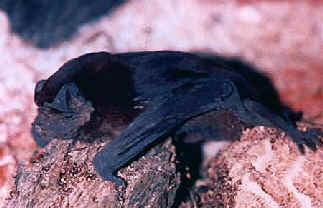
Velvety Free-tailed Bat
- Black Mastiff Bat ______
Molossus rufus
- Broad-eared Bat ______
Nyctinomops
laticaudatus
- Big Free-tailed Bat _______
Nyctinomops macrotis
- Big Crested Mastiff Bat ______
Promops centralis
- Brown Mastiff Bat ______
Promops nasutus
- Brazilian
(or Mexican)
Free-tailed Bat (ph) ______
Tadarida brasiliensis
AR name: Moloso Comun
- Common Vampire Bat
______
Desmodus rotundus
AR name: Vampiro Comun
- White-winged Vampire Bat ______
Diaemus youngi
- Southern Myotis ______
Myotis aelleni
- Silver-tipped Myotis ______
Myotis albescens
- Chilean Myotis ______
Myotis chiloensis
- Myotis dinellii
______
- Hairy-legged Myotis ______
Myotis keaysi
- Yellowish Myotis ______
Myotis levis
- Black Myotis ______
Myotis nigricans
- Riparian Myotis ______
Myotis riparius
- Red Myotis (nt) ______
Myotis ruber
- Velvety Myotis ______
Myotis simus
- Brazilian Brown Bat ______
Eptesicus brasiliensis
- Diminutive Serotine ______
Eptesicus diminutus
- Argentine Brown Bat ______
Eptesicus furinalis
- Thomas' Big-eared Brown Bat (nt)
______
Histiotus laephotis
- Big-eared Brown Bat ______
Histiotus macrotus
- Southern Big-eared Brown Bat ______
Histiotus magellanicus
- Small Big-eared Brown Bat ______
Histiotus montanus
- Tropical Big-eared Brown Bat ______
Histiotus velatus
- Desert Red Bat ______
Lasiurus blossevilli
AR name: Murcielago Rojizo
- Hoary Bat ______
Lasiurus cinereus
- Southern Yellow Bat ______
Lasiurus ega
- Cinnamon Red Bat ______
Lasiurus varius
various bats during FONT tours (*) ______ nc
ne
Marine Mammals:
RIGHT WHALES - Family Balaenidae
- Southern Right Whale (*) ______ so
Eubalaena australis
AR name: Ballena Franca Austral
The Southern Right Whale has been said by some to be conspecific with
the North Atlantic Right Whale, Eubalaena
glacialis, and the North
Pacific Right Whale, Eubalaena japonica.
Nice numbers of Southern Right Whales have been seen well during FONT tours
in southern Argentina in October and November, seen in the ocean by the coast of the Valdez
Peninsula.
BALEEN WHALES - Family Balaenopterinae
- Antarctic Minke Whale ______
Balaenoptera
bonaerensis
- Northern Minke Whale (ph)
______
Balaenoptera
acutorostrata
- Sei Whale (t2) ______
Balaenoptera borealis
- Bryde's Whale _______
Balaenoptera edeni
- Fin Whale (ph) ______
Balaenoptera physulus
- Blue Whale (ph) ______
Balaenoptera musculus
- Humpback Whale (ph) ______
Megaptera novaeangliae
SPERM WHALES - Families Physeteridae & Kogiidae
- Great Sperm Whale (ph) ______
Physeter macrocephalus
- Pygmy Sperm Whale (ph) ______
Kogia breviceps
- Dwarf Sperm Whale ______
Kogia sima
PYGMY RIGHT WHALE - Family Neobalaenidae
- Pygmy Right Whale ______
Caperea marginata
BEAKED & BOTTLENOSE WHALES - Family Ziphidae
- Cuvier's Beaked Whale (ph)
______
Ziphius cavirostris
- Arnoux's Beaked Whale ______
Berardius arnuxii
- Shepherd's Beaked Whale ______
Tasmacetus shepherdi
- Andrews' Beaked Whale ______
Mesoplodon bowdoini
- Gray's Beaked Whale ______
Mesoplodon grayi
- Hector's Beaked Whale ______
Mesoplodon hectori
- Strap-toothed Whale ______
Mesoplodon layardii
- Southern Bottlenose Whale ______
Hyperoodon
planifrons
MARINE DOLPHINS - Family Delphinidae
- Killer Whale (ph) (*) ______ so
Orcinus orca (the single member of its genus)
AR name: Orca
Orcinus orca
is also called the Orca.
Orcas have been seen during FONT tours along the coast of the Valdez
Peninsula, in the surf in areas where sea lions and elephant seals are on the beach.
- False Killer Whale ______
Pseudorca crassidens
- Dusky Dolphin (ph) (*) ______ so
Lagenorhynchus obscurus
AR name: Delfin Oscuro

Dusky Dolphins photographed during a FONT tour
- Peale's Dolphin (ph) (*) ______
fs (tf)
Lagenorhynchus australis
AR name: Delfin Griseoblanco
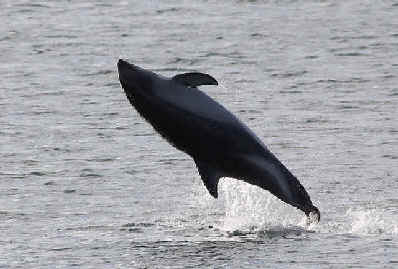
Peale's Dolphin
(photo by Cameron Rutt)
- Hourglass Dolphin ______
Lagenorhynchus cruciger
- Commerson's Dolphin (ph) (*)
______ fs (tf)
Cephalorhynchus
commersonii
AR name: Tonina overa
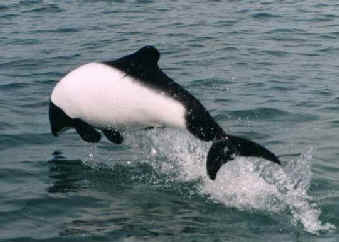
Commerson's Dolphin
- Chilean Dolphin (nt) ______
Cephalorhynchus
eutropia
- Common Bottle-nosed
Dolphin (ph) ______
Tursiops truncatus
AR name: Tonina
- Pantropical Spotted Dolphin ______
Stenella attenuata
- Striped Dolphin ______
Stenella coeruleoalba
- Spinner Dolphin ______
Stenella longirostris
- Short-beaked Common Dolphin
(ph) ______
Delphinus delphis
- Long-beaked Common Dolphin ______
Delphinus capensis
- Fraser's Dolphin (ph) ______
Lagenodelphis hosei
- Southern Right Whale Dolphin ______
Lissodelphis peronii
- Risso's Dolphin (ph) ______
Grampus griseus
- Long-finned Pilot
Whale (ph) ______
Globicephala melas
AR name: Delfin Piloto
RIVER DOLPHIN - Family Platanistidae
- La Plata Dolphin (or
Franciscana) ______
Pontoporia blainvillei
AR name: Delfin del Plata
PORPOISES - Family Phocoena
- Spectacled Porpoise ______
Phocoena dioptrica
- Burmeister's Porpoise ______
Phocoaena
spinipinnis
EARED SEALS - Family Otariidae
- South American Sea Lion (ph)
(*) ______ fs (tf) so
Otaria flavescens (the single member of its genus)
AR name: Lobo Marino Austral
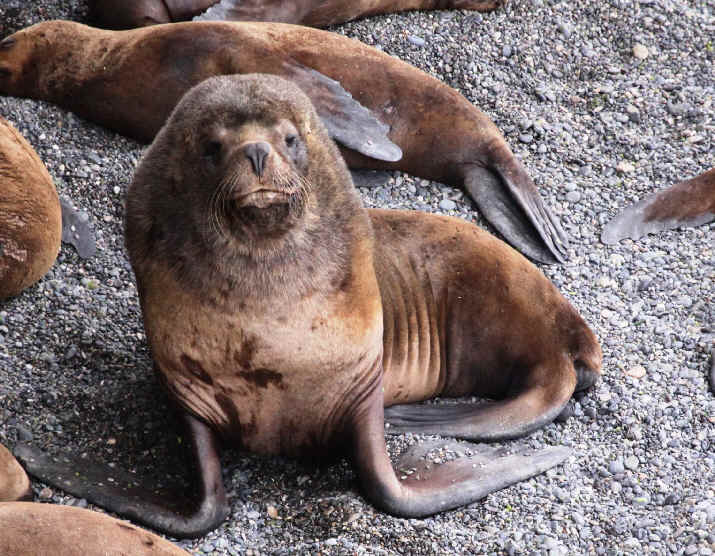
The South American Sea Lion photographed
during
the FONT Southern Argentina Tour in December 2013
(photo by Marie Gardner)
- South American Fur Seal (*) ______ fs
(tf)
Arctocephalus australis
AR name: Lobo Fino Patagonico
EARLESS SEALS - Family Phocidae
- Southern Elephant Seal (ph) (*)
______ so
Mirounga leonina
AR name: Elefante Marino Austral
The male Southern Elephant Seal is the largest seal in the
world, followed in size by the Northern Elephant Seal and the
Leopard Seal.
The male Southern Elephant Seal is four to five times the size of the
female.
A single male Southern Elephant Seal can have as many as 150
females in its harem.
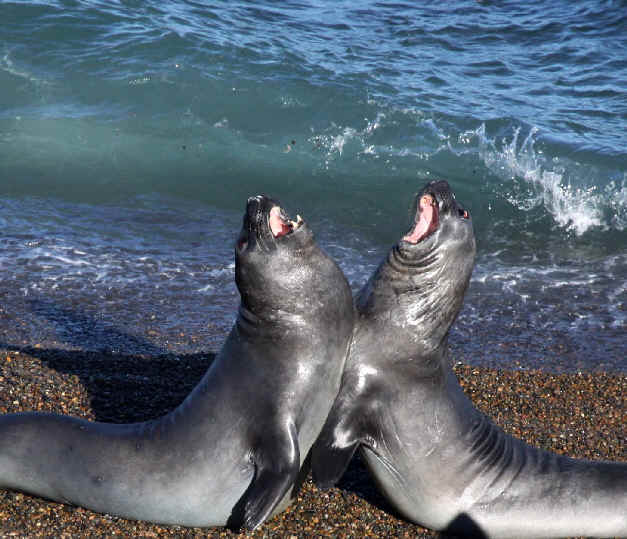
Two Southern Elephant Seals photographed during
the FONT tour
in southern Argentina in December 2013
(photo by Marie Gardner)
When they are not on the beach, and are far out at sea, Southern
Elephant Seals spend very little time at the surface of the water.
They dive repeatedly, generally for more than 20 minutes, hunting their
prey, squid and fish, at depths of 1,300 to 3,300 feet below the surface of
the sea.
They are the deepest diving air-breathing non-cetaceans, going as deep as
the maximum record of 6,998 feet.
Adult female Southern Elephant Seals typically weight from 880 to
2,000 pounds.
Adult males weigh from 4,900 to 8,800 pounds, and measure from 14 to 19 feet
long.
An adult female averages 1,700 pounds in weight. Mature males
average 7,000 pounds.
The largest ever measured was 22.5 feet long and was estimated to weigh
11,000 pounds.
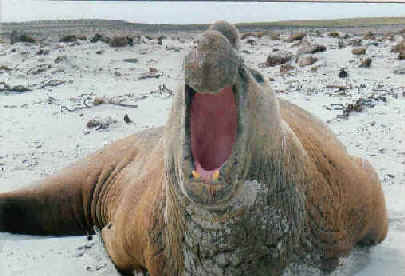
A male Southern Elephant Seal
(photo by Hubert Hall)
To Top of Page


![]()









































